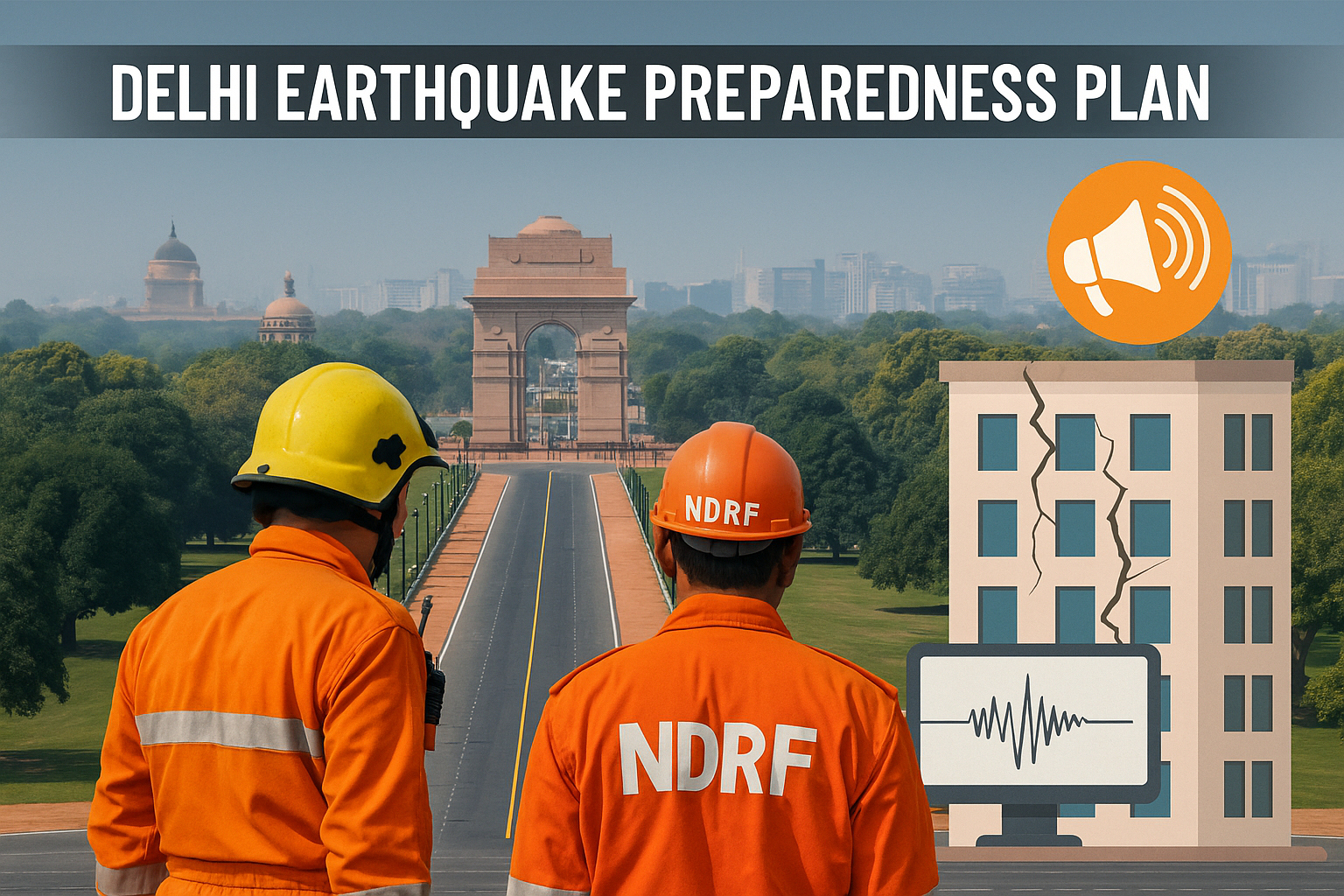The Delhi government has accelerated its long-awaited earthquake preparedness plan, launching a citywide initiative to strengthen response systems and safeguard citizens in one of India’s most seismically sensitive regions.
With Delhi located in Seismic Zone IV, the second-highest risk category in the country, officials have acknowledged that existing measures are inadequate for a large-scale event. The new action plan focuses on prevention, rapid response, and public participation to make the capital safer.
Renewed Urgency After Recent Tremors
After mild earthquakes were felt across northern India earlier this month, the Delhi Disaster Management Authority (DDMA) convened an emergency review chaired by Chief Secretary Rajeev Verma.
He directed departments to fast-track implementation of the State Earthquake Preparedness and Response Plan, a framework that had been under review for several years.
Officials said the strategy emphasizes stronger coordination, safer construction practices, and public education on disaster response.
“Delhi’s vulnerability is not only about geography but also about how densely we are built,” a DDMA official noted. “Preparedness must begin at the community level.”
Key Measures in Delhi’s Earthquake Preparedness Plan
The new plan covers both infrastructure and community resilience, combining modern technology with on-ground readiness.
Establishing a State Disaster Management Force (SDMF)
The government is creating a State Disaster Management Force (SDMF), a specialized unit trained in search and rescue, first aid, fire control, and debris clearance.
Personnel will be deployed across Delhi’s districts to ensure quick mobilization during emergencies.
Retrofitting Unsafe and Aging Structures
Authorities will carry out structural safety audits of public buildings, schools, hospitals, and government offices.
Unsafe buildings, especially in unauthorized colonies and heritage areas, will be prioritized for retrofitting in line with the Bureau of Indian Standards (BIS) codes for earthquake-resistant design.
Property owners in vulnerable zones will be encouraged to consult certified engineers and follow the city’s updated construction guidelines.
Advanced Early Warning and Communication Network
The plan introduces a multi-channel early warning system that integrates:
- Public sirens and loudspeaker alerts in high-density areas
- Satellite phones and ham radio networks for emergency communication
- SMS and mobile app alerts for citizens and responders
The system will be linked to real-time seismic data from the Indian Meteorological Department (IMD) and the National Disaster Management Authority (NDMA).
Community Awareness and Local Preparedness
The DDMA will organize training programs and mock drills across schools, offices, and residential areas.
Resident Welfare Associations (RWAs) will be trained to form local emergency response teams capable of basic rescue, first aid, and evacuation.
A network of community disaster cells will be established in each district, ensuring communication between local volunteers and the SDMF.
Regular Mock Drills and Inter-Department Coordination
To strengthen coordination, biannual multi-agency drills will include participation from Delhi Police, Fire Services, the Health Department, DMRC, and Public Works Department.
These exercises will test response speed, communication systems, and evacuation efficiency under simulated disaster conditions.
Why the Capital Needs an Upgrade in Earthquake Readiness
Experts have long warned that Delhi’s unplanned urbanization makes it particularly fragile during earthquakes.
The city’s seismic risk is heightened by:
- More than 1,700 unauthorized colonies with non-standard construction
- A dense population of over 3 crore residents in the NCR
- Aging heritage structures that have never been assessed for quake safety
- Traffic congestion that can delay rescue operations
A recent NDMA report highlighted that a moderate 6.0 magnitude earthquake could cause severe damage in central and east Delhi if preparedness measures remain weak.
“This plan is essential. The cost of preparedness is far lower than the cost of post-disaster recovery,” said structural engineer Anirudh Bhatia, who advises on retrofitting projects.
Addressing the Challenges Ahead
Officials admit that several practical challenges must be resolved before Delhi can achieve full readiness:
- Shortage of trained responders in existing disaster management teams
- Lack of seismic engineering expertise in local building departments
- Funding limitations for citywide retrofitting projects
- Poor coordination between civic bodies and enforcement agencies
To overcome these gaps, the government is seeking technical support from NDMA and the Central Building Research Institute (CBRI) and exploring public-private partnerships for large-scale safety audits.
How Residents Can Contribute to Safety
Authorities emphasize that earthquake safety begins with citizens. Residents can take simple but effective steps to minimize risks:
- Identify safe open areas and exit routes near homes and workplaces
- Avoid placing heavy furniture or water tanks on rooftops
- Keep an emergency kit ready with first aid supplies, flashlight, and essential documents
- Participate in RWA-led mock drills and awareness sessions
“A well-prepared household can make all the difference in the first critical minutes after a quake,” a DDMA spokesperson said.
Building a Safer Delhi
With the new plan in motion, Delhi aims to shift from reactive to preventive disaster management.
The implementation will begin in phases, focusing first on central and south Delhi, followed by expansion to high-risk zones such as East Delhi and the outer districts.
The State Disaster Management Force (SDMF) is expected to become operational by mid-2026, marking a significant step toward building a safer, more resilient capital.
FAQs
Is Delhi at real risk of a major earthquake?
Yes. Delhi is located in Seismic Zone IV, classified as a high-risk seismic area. Experts warn that the city’s dense population, unplanned urban growth, and old building stock make it particularly vulnerable. Even a moderate quake could cause structural damage in central and eastern parts of the city.
What is the State Disaster Management Force (SDMF)?
The State Disaster Management Force (SDMF) is a new, specialized response unit being set up under the Delhi Disaster Management Authority (DDMA). It will have trained personnel for rescue, first aid, debris removal, and emergency coordination during earthquakes or other disasters. The SDMF will be operational across districts for faster local response.
What are the main steps in Delhi’s earthquake preparedness plan?
The Delhi government’s new plan includes:
- Creating the SDMF for rapid response.
- Conducting safety audits and retrofitting of schools, hospitals, and heritage sites.
- Installing early warning systems with sirens and SMS alerts.
- Organizing mock drills and public awareness drives.
- Improving coordination among agencies like Delhi Police, Fire Services, PWD, and Health Department.
How will the early warning system work in Delhi?
The early warning system will use a mix of ground sensors, satellite networks, and mass alert technology. Once seismic activity is detected, alerts will be issued via public sirens, mobile notifications, and government apps. The system will link directly with IMD and NDMA for real-time communication.
Which parts of Delhi are most vulnerable to earthquakes?
Areas with old or unplanned buildings such as Chandni Chowk, Paharganj, East Delhi, and parts of South Delhi are most vulnerable. Unauthorized colonies and heritage zones face higher risks due to outdated construction practices and limited retrofitting.
What can Delhi residents do to prepare for an earthquake?
Citizens can take simple steps to improve safety:
- Identify safe open areas and exit routes at home and work.
- Keep an emergency kit with first aid, water, and essential items.
- Avoid placing heavy furniture or storage items on rooftops.
- Join community drills and awareness workshops run by RWAs or schools.
- Learn basic first aid and evacuation steps.
What is building retrofitting and why is it important?
Retrofitting means strengthening an existing building to withstand earthquakes. It often includes reinforcing walls, columns, and foundations.
The Delhi government is starting retrofitting in schools, hospitals, and high-risk public buildings to prevent collapse during tremors.
Who will coordinate Delhi’s earthquake response?
The Delhi Disaster Management Authority (DDMA) will lead the response with help from the SDMF, Delhi Police, Fire Services, Health Department, and district administrations. All agencies will work through a unified command system for faster communication and on-ground coordination.
How can citizens report unsafe or risky buildings?
Residents can report unsafe constructions or visible structural cracks to their local municipal corporation office or the Public Works Department (PWD). The government is also planning a dedicated online portal for reporting unsafe structures.
When will Delhi’s earthquake plan be fully implemented?
Implementation will happen in phases starting in 2025, focusing first on central and south Delhi. The State Disaster Management Force (SDMF) is expected to be fully functional by mid-2026, once recruitment and training are complete.

